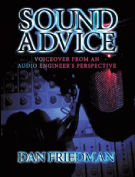Recording Magazine sends out a newsletter to its subscribers every few weeks. The newsletter is (coincidentally) titled “Sound Advice” and this month it features the first in a series about room acoustics. As you will read, room acoustics is one of the biggest concerns for Recording Magazine readers. I know that this is also a big issue for those of you in the voiceover world. So, I asked permission to reprint this newsletter (and will ask to reprint the others in the series as well) so that those of you with home studios can also benefit from the information. I want to personally thank Brent Heintz, VP/Associate Publisher for granting permission, allowing me to share this great information with you.
Please visit Recording Magazine‘s website and their Facebook Page.
Skip ahead to Part 2, Par1 3, Part 4, Part 5, Part 6, Part 7, Part 8.
Here is the newsletter:
Welcome to Sound Advice on Acoustics! In a recent survey of our readership, the number one answer to the question, “What do you feel most limits the quality of your home recordings?” was “Room acoustics.” There’s a lot to learn about the subject of acoustics, and the more you know, the more tricks you can master to get your room sounding its best.
New York-based producer/engineer Joe Albano brings us the first installment of a multipart primer on acoustics to get this newsletter started, and over the coming months we’ll bring you all kinds of useful information on acoustics! Here we go…
***
We’ll start our look at acoustics by briefly reviewing the basics of how sound works.
Sound is created by vibrating objects like guitar strings, drum heads, vocal cords, or loudspeakers; it travels through the air in waves. The waves are alternating areas of higher and lower air pressure; everything we do to control the sound of a room boils down to managing what happens to those waves as they move around the room.
When we talk about a sound wave or audio signal, it has some properties that we’ll need to understand.
1. There’s its amplitude (what we perceive as “loudness”). This is measured indecibels or dB. The decibel is a relative measure of loudness, and needs a reference point to have an absolute value (we talk about 0 dB Full Scale in digital audio all the time, for example). In acoustics, we’re usually talking about dB SPL or Sound Pressure Level, from the threshold of human hearing at 0 dB SPL all the way up to very loud sounds above 100 dB SPL.
2. There’s its frequency, or how many times per second the wave compresses air; it’s measured in wave cycles per second, or Hertz (Hz). We say that the A above middle C has a frequency of 440 Hz.
3. There’s its waveshape. All sound waves are made up of a combination of basic simple waves called sine waves. There’s the lowest frequency wave, thefundamental, and then a mix of higher-frequency information blended into it calledovertones. Every sound has a different blend of overtones over time; that’s what makes a flute playing a C sound different than a horn or guitar playing the same note.
Some overtones are multiples of the fundamental—if the fundamental is at 55 Hz, there may be overtones at 110, 220, 440, etc.. These overtones are called harmonics. Other overtones are inharmonic, without this clear relationship to the fundamental. We hear them as clangorous or noisy, like the attack of a ringing bell or the chiff of breath on a flute.
4. There’s its wavelength… how long a distance you can measure between the start of one wave and the start of the next. This is a really important property, because how a sound wave “fits” into a room has a direct bearing on how loud or controllable it is!
We can calculate the wavelength of any wave if we know its frequency and its speed; this applies to light waves, sound waves, any kind of wave. The formula is simple:
Speed = Frequency times Wavelength, so Wavelength is Speed divided by Frequency.
Now, we know the speed of sound in air at sea level; it’s 1130 feet per second (fps). So a sound wave’s wavelength in feet equals 1130 fps divided by the frequency in Hz.
Here’s a couple of examples: A low E on a guitar has a fundamental frequency of 82 Hz; its wavelength is 1130 / 82 = 13.8 feet. That’s a pretty long wave. Compare that with the highest C on a piano. Its fundamental frequency is 4000 Hz, so its wavelength is 1130 / 4000 = 0.28 feet, or a bit over 3 inches: a much shorter wave.
So, as you can imagine, when we play back music on loudspeakers or have a set of instruments playing in a room, there are all kinds of waves bouncing around at all kinds of wavelengths. When two of them happen to line up so that a high pressure area of one is at the same place as another high pressure area, the overall pressure will be still higher, i.e., the wave will be louder. And when two of them line up so that a high pressure area of one is at the same place as a low pressure area of another, they’ll partly cancel out and the wave will be softer.
In other words: in any given room where there’s sound, certain frequencies will be louder than you think they’d normally be, and certain frequencies will be softer. The room won’t be accurate in representing the actual sound being played, and if you track and mix in such a room then play your music back elsewhere, it won’t sound the way you think it should. Presto: you now know why acoustics and sound control in rooms is so important!
Next time, we’ll start to look at how these properties of sound combine to create real-world acoustic problems. See you then!
 Since returning from Italy a couple of weeks ago, I’ve been dealing with a trademark issue regarding the name of my website. While I won’t express my thoughts about the need for this change or even get into the specifics, I will say that it is great to know that my book
Since returning from Italy a couple of weeks ago, I’ve been dealing with a trademark issue regarding the name of my website. While I won’t express my thoughts about the need for this change or even get into the specifics, I will say that it is great to know that my book 


